April Fool – with the Mimic Octopus
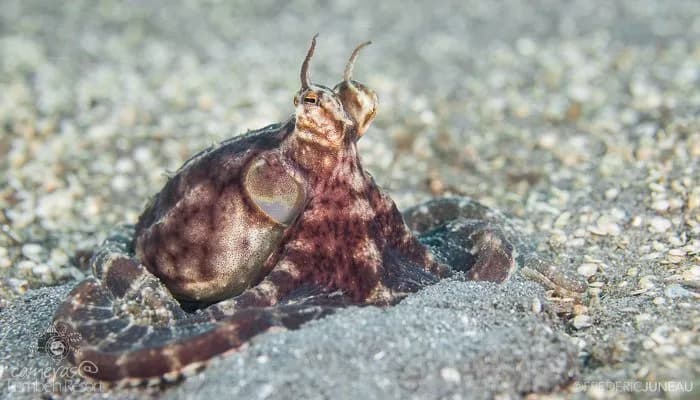
This month we have been thinking about aquatic April Fools and the “Critter King of Confusion” award goes to the mimic octopus (Thaumoctopus mimicus). This master of mimicry is famous for its ability to fool other critters with Oscar worthy displays and impersonations but how much do you know about the mimic octopus? Find out more here…
- It’s all in the name: The mimic octopus takes its name from its ability to mimic other sea creatures, most notably lionfish, flounders, sea snakes, and jellyfish.
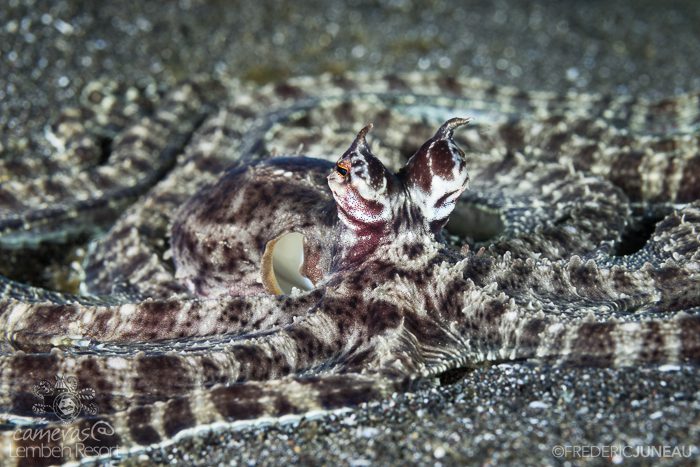
The mimic octopus is a highlight of diving in the Lembeh Strait
- Appearance: Mimics are a smaller species of octopus growing up to a total length of around 60cm. The arms grow up to 30cm long and have a two-tone pattern of white banding on a dark brown background which will lighten or darken when it is distressed. Each arm is bordered by a solid white line / margin.
- Activity: Mimic octopus are active during the day time but can be difficult to spot as they are often in the sand with only their head protruding.
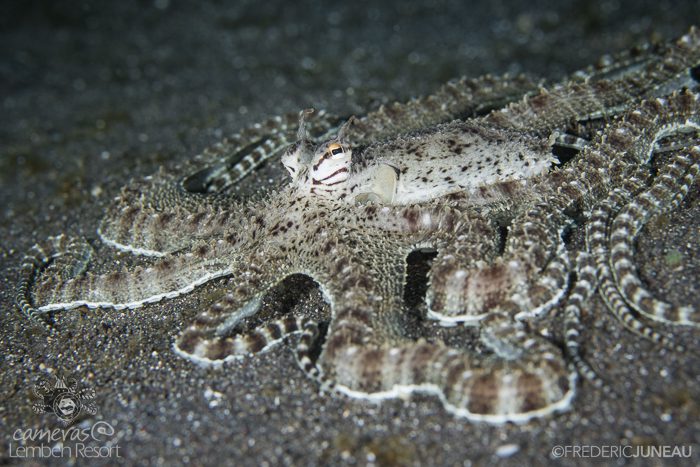
The mimic can gather it’s arms together to impersonate a flounder. Note the white arm band.
- Blending in: Like other octopus species, the mimic is able to blend in with its background by adapting its color and skin texture accordingly. When motionless, the octopus’s assumed body patterns and posture resembled small sponges, tube-worm tubes, or colonial tunicates, which are the most common features found on our black sand dive sites here in Lembeh. When the mimic is out on the open sand, this is when it is most likely to rely on fish and critter mimicry to go undetected.
- Ability: Mimic octopus are reputed to mimic up to 15 species of marine organisms (some sources quote more than 20 species). Some of the more unusual species include sand anemones, stingrays, mantis shrimp, and even jellyfish.
- Recent Debates: Some cephalopod scientists have questioned the extent of the mimic’s mimicry as it is impossible to know the mimic’s intention during these displays. The seemingly unanswerable question of, “is the octopus intending to mimic the species or just displaying natural (non-mimicry) behaviour which we (humans) are interpreting as an attempt at mimicry” looks set to keep scientists baffled for some time to come!
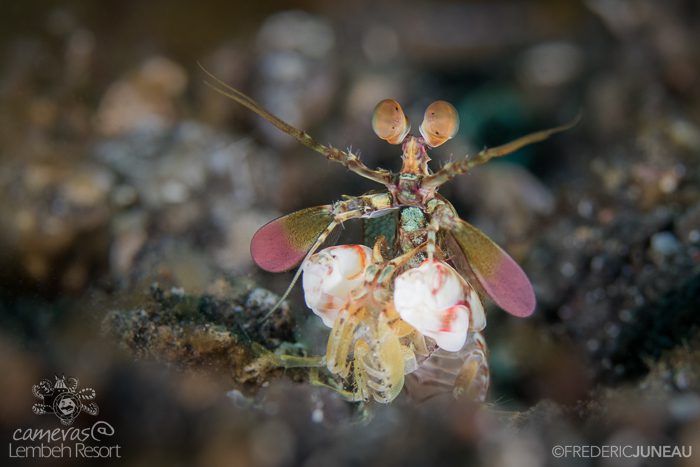
Mimic octopus are able to “mimic” mantis shrimps
- Due to the mimic favoring estuaries and relatively barren environments as opposed to coral reefs it went unnoticed by divers for decades. Did you know that the mimic octopus is a relatively “new” species and it was actually only discovered here in Sulawesi in 1998?
Do You Know Your Mimic From You Wunderpus?
These two species are both found here in the Lembeh Strait and are often misidentified but there are a few tell-tale signs to look out for when trying to distinguish between the two.
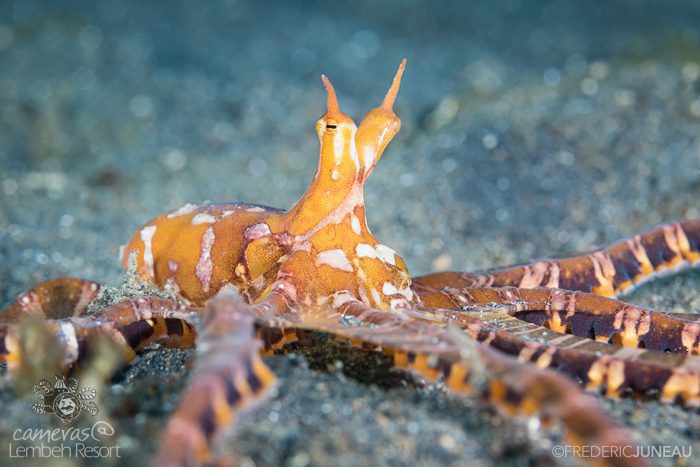
The wunderpus has a more reddish coloration and no white margin on it’s arms
- Wunderpus octopus are more reddish brown than mimics.
- Wunderpus eye-stalks are much more elongated than those of a mimic octopus.
- Mimic octopus have a distinctive white line which borders each of its arms. This white line is absent in wunderpus.
- Wunderpus are more active early in the morning and early evenings, where as mimic octopus are active during the day.
- The wunderpus displays a strong contrast between dark and light areas of its skin whereas the mimic’s light and dark areas are more subtle and blended.
Mimic Octopus in the Lembeh Strait
Are you hoping to see the magnificent mimic octopus in action here in Lembeh? This month we have been having great sightings at both Air Bajo and Rojos. As with many of the critters in the Lembeh Strait, mimic octopus are not seasonal but they do like to move around from dive site to dive site throughout the year. Our incredible team of Dive Guides are trained in Marine Biology which helps them immensely when spotting critters. They are always one step ahead of the game and will know where is hot for sightings at the time you visit. Let them know what you’d like to see!
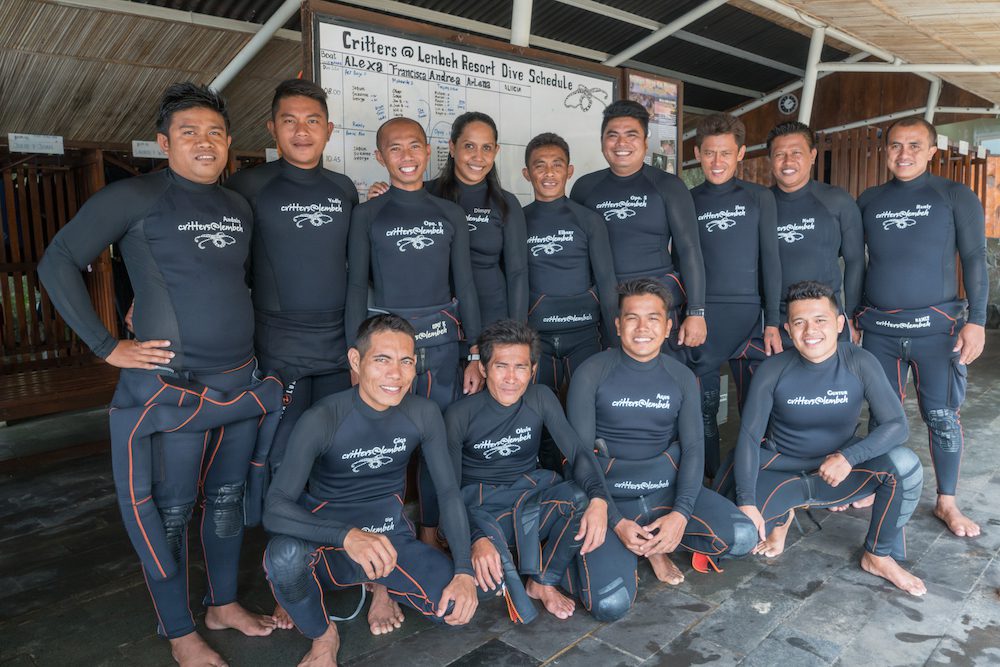
Lembeh Resort Dive Guides are marine biology and underwater photography trained
Are you already planning a trip to the Lembeh Strait? Lembeh Resort offers unparalleled luxury accommodation in North Sulawesi and is the only dive resort in the Strait which offers a full time, on-site Photo Pro, two Marine Biologists, dedicated Photo Center and Camera Room AND photography and marine biology trained Dive Guides.
Discover Lembeh Resort rates and secure your unforgettable stay at our beautiful Indonesian Resort. Contact us at: reservations@LembehResort.com for more information about diving with us and booking your accommodation.
We look forward to welcoming you to Lembeh Resort soon
Further Reading…
If you’ve enjoyed reading this Blog then you may be interested in reading more about the marine life species found here in the Lembeh Strait:
– Wunderpus Octopus
– It’s All About The Bobbit Worm
– The Flamboyant Cuttlefish (Metasepia Pfefferi)



